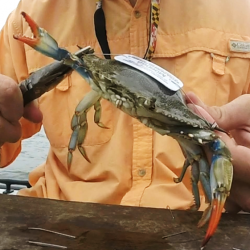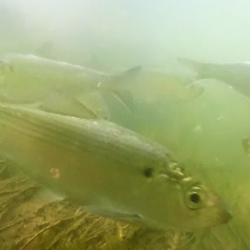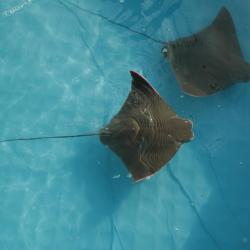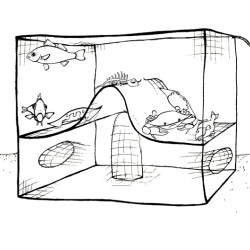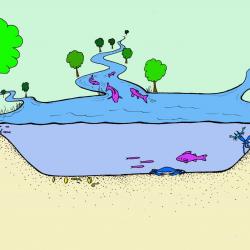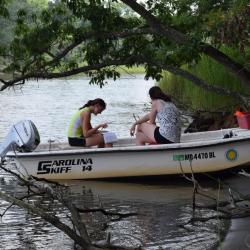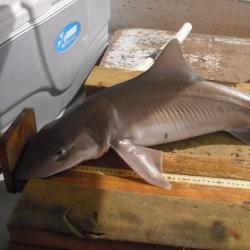Principal Investigator
The Fisheries Conservation Lab investigates the ecology, management, and conservation of marine and estuarine fisheries. We depend on fisheries for many things including food, employment, recreational opportunities, and cultural identity, but fishing and aquaculture rank among the greatest human impacts on marine ecosystems. Finding a balance between harvest and conservation of fishery species and mitigating the impacts of fisheries on marine ecosystems will be key to sustaining productive, resilient, and biodiverse coastal and marine ecosystems for future generations.
Our interdisciplinary research focuses on providing the best scientific information available to inform fisheries management and conservation decision-making at scales from local communities to global institutions. We apply field and laboratory experiments, animal tracking technologies, models, long-term observational studies, and historical perspectives to address fisheries issues including sustainability of fished populations, altered food webs and trophic interactions, linkages between environment and fisheries, and invasive species. We engage in collaborative research through:
Smithsonian Story Highlights Community-based Oyster Reef Monitoring
Posted by Matt Ogburn on February 3, 2025

Fisheries Ecology and Conservation
Understanding the ecology of fisheries is critical to maintaining resilient, productive and biodiverse coastal and marine ecosystems. Fishing is an important sector of coastal economies, provides an important supply of food for human societies, and is an activity of great cultural and historical importance. But fisheries have also contributed to the decline of coastal and marine ecosystems through changes in biomass and community structure, disruption of food webs, and alteration of habitats. Using the Chesapeake Bay as a model system, we are addressing fisheries issues including the impacts of harvest, restoration, and conservation on populations, communities and ecosystems, habitat use, migrations and connectivity with other coastal ecosystems. To learn more about our fisheries ecology and conservation research, please visit the following webpages:
Long-Term Studies of Nearshore Ecosystems
Our long-term studies of fish and invertebrate communities in the Rhode River, Maryland study site offer a window in the community structure and population dynamics of fish and invertebrate communities in one of the most productive ecosystems on earth, the Chesapeake Bay. Spanning more than three decades, this research tracks seasonal, annual, and decadal variation in species composition and abundance of fishes and macro-invertebrates. Sampling methods include trawling, seining, a fish weir, benthic infauna cores, and tethering experiments. The long-term descriptive data, in combination with our experimental studies, provide an unusual database for exploring populations, communities, predator-prey relationships, impacts of fisheries, and impacts of environmental variability, and other ecological processes. To learn more about our long-term research, please follow the links below:
Movement of Life Initiative
Many species on the planet migrate during their lifetime, using different habitats during specific life stages. What habitats are most important and why? How does environmental variability affect migrations? What are the benefits and costs of migration to individuals? How can we best manage fisheries for migratory species? How do migratory species affect community structure and ecological processes? To learn more about our Movement of Life Initiative research, please visit our Movement of Life Initiative webpage:
Welcome to the Educator Resources page-- below are a collection of lessons, web resources, and videos arranged by subject to help you quickly find resources in your interest area to create lesson plans or activities. Maryland follows the Next Generation Science Standards for K-12 science content standards. Access the Next Generation Science Standards broken down by topic at the National Science Teachers Association website.
Are you a teacher visiting SERC? Click here to learn more about how to prepare for your field trip to our campus and other general resources!
Discover, create, and share more resources and educational experiences on the Smithsonian Learning Lab!
Sharks, rays, and whales
Lesson: Movement of Life Initiative: Protecting Whales
Grade 3
NGSS, Computer Science Teachers Association Standards, ISTE Student Standards
https://ssec.si.edu/whales
Lesson: Movement of Life Initiative: Discover What Makes Sharks Move
Grade 4
NGSS
https://learninglab.si.edu/collections/movement-of-life-initiative-discover-what-makes-sharks-move/74MV9mDjnp7PvG9k#r
Lesson: Sharks and Shorelines
Grades 6-10
NGSS
https://natureworkseverywhere.org/resources/sharks-shorelines/
Activity: Ecosystem Explorer | EARTH A New Wild
Grades 5-8
NGSS
https://www.pbslearningmedia.org/resource/5aeed659-7f0b-417f-81d9-5f2e9c...
Reading/ Video: SERC’s Shorelines Blog "Following the Movement of Life: Tagging Sharks and Rays"
Grades 5-7
https://sercblog.si.edu/?p=8571
Reading/ Video: SERC’s Shorelines Blog "Tracking the Bay’s Cownose Rays"
Grades 5-7
https://sercblog.si.edu/?p=6254
For more information about shark migration, check out Smithsonian's Movement of Life Initiative!
Blue Crabs
Lesson: The Blue Crab's Chesapeake Journey
Grade 9-12
http://www2.vims.edu/bridge/DATA.cfm?Bridge_Location=archive1102.html
Video: SERC Scientists Video from the Smithsonian Science Education Center, “How do Scientists Track and Monitor blue Crab Populations in the Chesapeake Bay?
Grades 3-8
https://ssec.si.edu/explore-smithsonian-how-do-scientists-track-and-moni...
Video: SERC Ecosystems on the Edge video by one of our scientists, called “Blue Crabs: Top Predator in Peril”
Grades 3-8
https://ecosystemsontheedge.org/top-predator/
Oysters
Lesson: Juvenile Oyster Disease: A Growing Problem
Grade 9-12
https://masweb.vims.edu/bridge/datatip.cfm?Bridge_Location=archive0103.html
Video: Determining the Resiliency of Juvenile Oysters in the Chesapeake Bay
Grade 3-8
Activity Book: The World is Your Oyster: Activity and Coloring Book
Grade 2-5
https://serc.si.edu/sites/default/files/website-gen/fish_con_coloring_booklet_final.pdf








